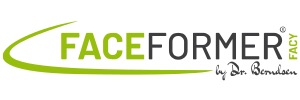Science and Research
Studies on FaceFormer Therapy
Studies on FaceFormer Therapy
Persisting orofacial dysfunctions impede the normal development of the orofacial and craniocervical region and reduce the stability of any orthodontic treatment. Myofunctional therapy is a treatment concept to harmonize orofacial function and is conducted by speech therapists. Because of waiting periods before the start of treatment and the duration of myofunctional therapy an overall time period of one to two years must be taken into account between referral and end of myofunctional therapy. Furthermore, individual treatment outcome depends on several factors.
During a six-month period, 45 patients aged 3.9 to 16.9 years were prospectively examined at three month intervals at the Polyclinic for Orthodontics of the University Medical Center Hamburg-Eppendorf. All patients showed multiple orofacial dysfunctions requiring treatment at the beginning of the study. Patients were randomly divided into a non-apparatus myofunctional therapy group [MFT group] (n = 19 patients) and an apparatus-based FaceFormer therapy group [FFT group] (n = 26 patients). The MFT group served as a control group, while the FFT group was the study group. Both groups were comparable with regard to age, gender and the extent of dysfunction. The findings, which were performed every three months, were based on a standardized examination form for patients with orofacial dysfunctions [90] and a functional examination form. Lip competence, breathing mode, articulation, lip habits, swallowing pattern and lip strength were diagnosed. On the basis of the available examination results, it was determined that harmonization of orofacial dysfunctions is possible with the aid of both functional therapy concepts. Within the observation period of six months, FaceFormer Therapy proved to be more efficient compared to myofunctional therapy in logopedic practices.
In comparison to nonapparatus myofunctional therapy, FaceFormer Therapy achieved highly significant results in establishing nasal breathing (p=0.001). At the beginning of the study, 88.5% of the subjects within the study group were diagnosed as having established nasal breathing. After six months, this could only be detected in 23.5% of the patients. In the control group, the proportion of patients with habitual mouth breathing decreased during the observation period from 94.7% at the beginning to 69.2%.
FaceFormer therapy is also superior to myofunctional therapy in establishing a physiological swallowing pattern (p=0.000). A somatic swallowing pattern was detected in all subjects of both therapy groups before the start of therapy. After six months, only 29.4% of the patients in the study group showed an unphysiological swallowing pattern, whereas 84.6% of the control group were diagnosed with this pattern.
In both groups, a highly significant increase in lip strength was demonstrated during the course of the study. Within the FaceFormer collective, however, this improvement was achieved in a shorter period of time. When comparing the development of average lip strength after three months of therapy, the available therapy results showed an increase in lip strength within the FaceFormer group by a factor of 2.35 (T0 = 11.23 mbar; T1 = 26.41 mbar). During the same period, the control group’s lip strength increased by a factor of only 0.31 on average (T0 = 14.28 mbar; T1 = 20.69 mbar).
In contrast to other studies, no significant improvements in the treatment of articulation disorders could be diagnosed in the present study within the observation period of six months.
Both approaches showed significant improvements within the six-month period. FaceFormer therapy was superior to myofunctional therapy. Due to the chosen observation period, this study does not allow any conclusions regarding the long-term stability of the achieved orofacial harmonization. This will be the subject of further clinical studies.
Poliklinik für Kieferorthopädie des Zentrums für Zahn-, Mund- und Kieferheilkunde
Universitätsklinikum Hamburg-Eppendorf
Direktorin: Prof. Dr. med. dent. B. Kahl-Nieke

The complete work can be found here in the holdings of the German National Library.
You can purchase your FaceFormer online in the Dr. Berndsen Shop, from our sales partners or from numerous doctors and therapists or locally in your pharmacy.
Ask for the central pharmaceutical number PZN 18092273 (FaceFormer ONE blue).
Further product variants and useful accessories are available.
Saving tip especially for doctors and therapists: 20%++ discount on orders of 5 FaceFormers or more!
The effective solution for snoring, sleep apnea, CMD, jaw problems and many other indications. Simple, causal, effective.
Wasserstr.25
59423 Unna
Germany
+49 (0) 23 03-89 99 1
+49 (0) 23 03 – 89 88 6
Mo. to Fr. from 8:00 to 16:00

 FaceFormer® Therapy – Efficient treatment of orofacial dysfunctions
FaceFormer® Therapy – Efficient treatment of orofacial dysfunctionsThis site uses cookies. By continuing to browse the site, you are agreeing to our use of cookies.
OK, agree with allAgree to essentialsShow settingsThe satisfaction of visitors to our website is important to us. In order to better address you, we use cookies. Thereby we achieve that the website works technically reliable and secure.
You can change or revoke your consent at any time.
In the privacy policy you can learn more about cookies and privacy setting.
View privacy policy
Essential cookies enable basic functionality and are necessary for the proper functioning of the website.
This data may be linked to user information of users logged in on youtube.com and google.com.
YouTube video embedding
Used to unlock YouTube content.
Google Analytics
Cookie from Google for website analytics.
Generates statistical data about how the visitor uses the website
